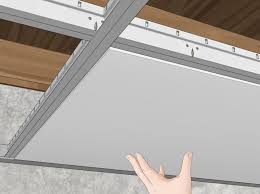Drop ceilings, also known as suspended ceilings or false ceilings, are a popular interior design feature that offers both practical and aesthetic benefits. From concealing unsightly ductwork and wiring to enhancing acoustics and insulation, drop ceilings have become a versatile solution for commercial and residential spaces alike. In this article, we’ll explore the design possibilities, installation process, and advantages of drop ceilings, providing insights into how they can elevate the look and functionality of any interior space.
Understanding Drop Ceilings
Drop ceilings consist of a grid system suspended from the original ceiling structure, with ceiling tiles or panels resting within the grid. These tiles are typically made from materials such as mineral fiber, fiberglass, or metal, and come in a variety of sizes, shapes, and finishes to suit different design preferences and performance requirements.
Design Options and Aesthetic Appeal
One of the key advantages of drop ceilings is their versatility in design and aesthetic appeal. Ceiling tiles are available in a wide range of colors, patterns, and textures, allowing for endless customization possibilities. Whether you prefer a sleek and modern look with smooth, monolithic panels or a more traditional feel with textured tiles and decorative motifs, drop ceilings can be tailored to complement any interior style.
Enhancing Acoustics and Sound Control
Drop ceilings are known for their ability to improve acoustics and sound control in interior spaces. Certain ceiling tiles are specifically designed to absorb sound and reduce noise transmission. Making them ideal for environments such as offices, classrooms, and healthcare facilities where noise reduction is a priority. By minimizing reverberation and echo, drop ceilings create a quieter and more comfortable atmosphere for occupants.
Concealing Mechanical Systems and Wiring
One of the primary functions of drop ceilings is to conceal mechanical systems, ductwork, piping, and electrical wiring that may be present in the space above. By hiding these elements from view, drop ceilings create a clean and seamless appearance while maintaining accessibility for maintenance and repairs. This makes them particularly well-suited for commercial spaces such as offices. Retail stores, and restaurants where aesthetics and functionality are equally important.
Improving Insulation and Energy Efficiency
Drop ceilings can also contribute to improved insulation and energy efficiency in interior spaces. Certain ceiling tiles are designed with thermal properties that help regulate temperature and reduce heat loss or gain. Resulting in lower energy consumption and utility costs. By creating a barrier between the interior and exterior environment, drop ceilings help maintain a comfortable indoor climate year-round.
Installation Process and Considerations
The installation of a drop ceiling typically involves several steps, including:
- Planning and Design: Begin by assessing the space and determining the layout and design of the drop ceiling, taking into account factors such as room dimensions, lighting fixtures, and access points.
- Grid Installation: Install the suspension grid system according to the manufacturer’s instructions. Ensuring that it is level and securely anchored to the existing ceiling structure.
- Tile Installation: Once the grid is in place, insert the ceiling tiles or panels into the grid, making sure they fit snugly and are properly aligned. Cut tiles as needed to accommodate lighting fixtures, air vents, and other obstructions.
- Finishing Touches: Complete the installation by adding perimeter molding or trim to conceal the edges of the ceiling tiles and create a finished look.
It’s important to work with a qualified contractor or installer who has experience with drop ceiling installation to ensure a professional and seamless result.
Maintenance and Care
Drop ceiling are relatively low-maintenance and easy to care for. Regular cleaning with a mild detergent and water solution can help remove dust, dirt, and stains from ceiling tiles. Avoid using abrasive cleaners or harsh chemicals, as these may damage the surface of the tiles. In addition, inspect the ceiling periodically for signs of water damage. Sagging, or discoloration, and address any issues promptly to prevent further damage.
Conclusion
Drop ceilings are a versatile and practical solution for enhancing the aesthetics, acoustics, and functionality of interior spaces. From concealing mechanical systems and wiring to improving insulation and energy efficiency. Drop ceilings offer numerous benefits for both commercial and residential applications. By exploring the design options, understanding the installation process, and considering the advantages of drop ceilings. Homeowners and designers can create inviting and functional spaces that meet their specific needs and preferences. Whether you’re renovating an office, classroom, or residential property. Drop ceilings provide a customizable and cost-effective solution for transforming any interior environment.

